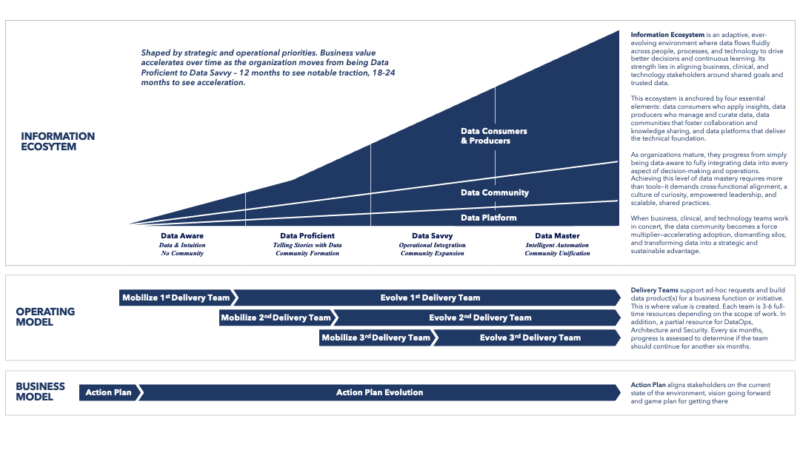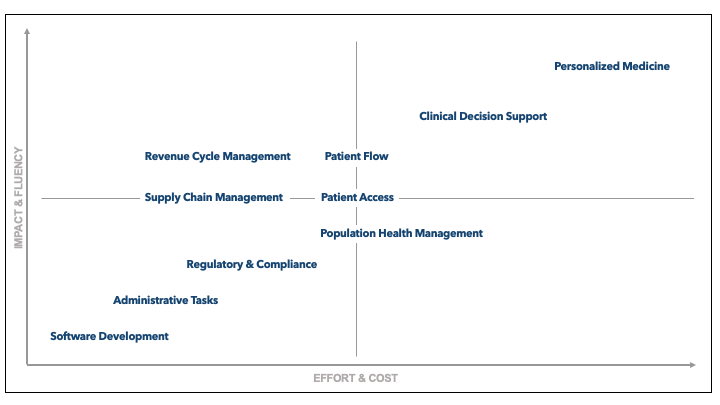
“No margin, no mission.” I have heard this more times in the last six months than in the previous eight years. Over half of healthcare systems finished with negative margins in 2022 and 2023. While 2024 shows signs of improvement, low margins (2-3%) are becoming the new norm. Many driving factors are involved, including increasing labor costs due to staffing shortages, high supply and drug costs, shifts in the payer mix, and challenges with reimbursement rates.
While there is very little we can do to impact these factors directly, there is an opportunity to drive cost out of the system by reducing waste. According to a JAMA article published in 2019, the authors estimate that 25% of healthcare expenses are waste. Other papers have gone as high as 30%. So, if the annual cost of healthcare in 2022 was $4.5 trillion, that translates to over $1 trillion in potential savings. Just imagine if you could harvest a fraction of these savings in your organization. This would be a game changer and, if done right, would improve the quality of care and enrich patient and employee experience.
So, it isn’t surprising that senior leaders have taken a great interest in tools that promote automation. This initially started with RPA (Robotic Process Automation) tools and has recently shifted to exploring advanced AI tools. However, my overall observation is that these efforts have had limited success. Much like continuous improvement programs that organizations have invested in heavily over the past decade, there continues to be significant waste in the system. Some incremental improvement is being realized, but we fail to see any step changes.
I am a BIG fan of automation and continuous improvement (CI). These efforts have transformed organizations like Amazon, Expedia, and Starbucks. Though some healthcare systems have had success, CI has yet to take hold in the same way in healthcare. There is no doubt many valid reasons worthy of a future blog. I believe a major driver is that many organizations have yet to become data-driven, and lack data fluency, tools, and culture.
That said, this doesn’t mean you need a mature, data-driven culture to get started with automation. However, there are a few things to consider.
Assessing Your Readiness
Throughout this series, we have discussed many aspects of becoming a data-driven community – operating model, innovative mindset, analytics and AI tools, data platform, etc. With each step on our journey, we evolve our data and capabilities, demonstrate value, learn to navigate organizational change and grow our data fluency. Like a flywheel, once momentum begins to build, each successive step requires less effort while demonstrating greater impact, as illustrated in the figure below:

So, if you are starting your journey (Year 1), that probably isn’t the best time to start with automation. To do this effectively, you must first understand the process you are trying to improve. This will involve capturing, integrating and analyzing data. This data will be used to understand the current state, develop the business case, measure progress, and likely power automation tools.
There are also many other areas of low-hanging fruit. Implementing self-service analytics and a dashboard framework (Pulse) will likely offer greater value, grow your maturity and prepare you for automation. Figure 2 below provides context for where automation capabilities fit in your evolution.

There are a few more things to consider. Data fluency and capabilities are NOT uniform across the organization. Revenue cycle and quality and safety may be much further along in their analytics and AI journey than supply chain or HR.
Another measure of readiness is whether you have willing participants at all levels impacted by automation. If not, don’t do it. To succeed, the people affected by the change need to be driving the change. If you are patient and continue to focus on other capabilities highlighted in Figure 2, data maturity will grow, and people will be ready for automation.
If, after considering this, you feel you have an area with the requisite maturity and willing participants, let’s take a deeper look at automation and areas to consider.
Intelligent Automation Defined
Let’s start by acknowledging that automation isn’t new. This is evident everywhere you look. Significant investments have been made in technology (EHR, ERP, CRM, etc.) to automate manual processes and promote better collaboration. Though these technologies have created value, they haven’t made the promised step change. In many cases, the cost savings are offset by the cost of using and administering these systems.
To improve on this, many organizations have begun to leverage RPA. This is a quick way to reduce the administrative workload and speed up existing processes. However, RPA fails to achieve the step change because it doesn’t fix the problem, it hides it. The operational systems are still unintelligent. To achieve the step change, intelligent automation is needed.
Our experience defines our understanding. My first exposure to intelligent automation was working at Amazon in the late 90s. At the time, my job as an analytics leader was to provide tools to help people be more effective. For example, providing merchandisers with analytical tools to create product assortments that would interest the consumer—state-of-the-art for retail at the time.
Then, the dot-com bubble burst. Driving waste out of the system became the priority for surviving the crisis and riding the wave of prosperity that always follows. So, we started to look beyond how we could make merchandizers more productive to how we could automate their work by leveraging our rich consumer dataset and algorithms—something legacy retail could never have considered.
One of the early successes that is familiar to most is product recommendations. Initially, this capability automated the work performed by hundreds of merchandizers, which was on par with humans. The longer-term benefit was that the foundation was created to provide a superior shopping experience. As the algorithm was tuned, leveraging the rich dataset that describes the entire store experience for each consumer, Amazon was able to provide a unique store experience for each consumer.
A more recent healthcare example was leveraging a self-service tool like AdaptX. Leveraging data and algorithms, this tool allows clinicians to do the analytics previously done by some combination of data engineers, analysts, and scientists. This significantly reduces the cost of doing analytics and makes analytics available to nearly every data consumer, dramatically expanding the scope of data innovation.
So, we can define “intelligent automation” as a capability that leverages the treasure trove of data and algorithms to replace the work previously done by humans. It is also worth noting that intelligent automation has a multiplier effect. As the human function is automated, it can be broadly expanded and personalized at almost zero cost. This is the power of automation and the step change we seek in healthcare.
That said, there is an essential nuance in healthcare. Many recommendations provided by intelligent automation require clinical review, compared to e-commerce, where a poor recommendation is inconvenient but not life-threatening.
Let’s look at how intelligent automation can be leveraged in healthcare.
Intelligent Automation Applied
Intelligent automation can be applied across various domains to improve efficiency, reduce costs, and enhance patient care. Here are some key areas where intelligent automation can make a significant impact:
1. Clinical Decision Support: Intelligent automation can analyze vast amounts of patient data, medical literature, and clinical guidelines to provide real-time recommendations to healthcare providers. This can include suggested diagnoses, treatment plans, and potential drug interactions. While these systems don't replace clinical judgment, they can significantly enhance decision-making and reduce errors.
2. Revenue Cycle Management: Automating billing and coding processes can dramatically reduce errors and accelerate reimbursement. Intelligent automation can review medical records, automatically assign appropriate codes, and flag potential issues for human review. This speeds up the billing process and helps ensure compliance with ever-changing regulations.
3. Patient Access: Intelligent automation can optimize appointment scheduling, reducing wait times and improving resource utilization. AI-powered triage tools can assess patient needs and direct them to the most appropriate level of care, whether telemedicine, urgent care, or the emergency department.
4. Patient Flow: Intelligent automation can manage bed assignments, predict patient discharges, and coordinate care transitions, streamlining patient flow throughout the facility. These systems can also provide real-time updates to patients about wait times and queue positions, improving communication and satisfaction. By leveraging data analytics and machine learning, healthcare providers can identify bottlenecks, predict periods of high demand, and allocate resources more effectively, ultimately leading to shorter wait times, improved access to care, and better overall patient outcomes.
5. Supply Chain Management: Predictive analytics can forecast medical supply and pharmaceutical demand, optimize inventory levels, and reduce waste. Automated systems can also monitor supply chain disruptions and suggest alternative sourcing strategies.
6. Population Health Management: Intelligent automation can analyze population-level data to identify high-risk patients, predict disease outbreaks, and suggest targeted interventions. This proactive approach can improve overall community health while reducing healthcare costs.
7. Personalized Medicine: By analyzing genetic data, patient histories, and treatment outcomes, intelligent automation can suggest personalized treatment plans that are most likely effective for individual patients.
8. Regulatory & Compliance: Monitor operations for compliance with regulations like HIPAA, automate regulatory reporting, track policy updates, and assist with audit preparation. These tools can also manage patient consent, detect potential fraud, and ensure compliance in clinical trials.
9. Administrative Tasks: Routine administrative tasks like appointment reminders, and document processing can be automated, freeing staff to focus on higher-value activities that require human interaction and judgment. ChatGPT, Claude, and other LLMs can be particularly effective. With a small investment, organizations can quickly reap rewards.
10. Software Development: Improving productivity in building products to capture, integrate, and analyze data is well positioned for a significant step change with the new GenAI tools. Software development is the domain where some of the early wins have been realized.
Please see the figure below to provide some context for the relative effort involved in implementing these domains, the potential impact, and the requisite level of data maturity. If you are just getting started, it is best to start in the lower left and possibly middle, depending on your level of data maturity.

Implementing Intelligent Automation
While the potential benefits of intelligent automation in healthcare are significant, successful implementation requires careful planning and execution:
1. Start Small: Begin with pilot projects in areas with solid data and clear processes. This will allow you to demonstrate value and build organizational support.
2. Focus on Data Quality: Ensure your data is accurate, complete, and properly structured. Poor data quality can lead to flawed automation and erode trust in the system. As discussed in previous pieces, the bar for data quality is much higher when using GenAI tools.
3. Involve Stakeholders: Engage clinicians, administrators, and IT staff throughout the process. Their input is crucial for designing systems that work in the real world.
4. Prioritize Ethics and Privacy: Develop clear guidelines for data use and algorithm development to ensure patient privacy and prevent bias.
5. Invest in Training: Provide comprehensive training to staff on how to work alongside automated systems and interpret their outputs.
6. Continuously Monitor and Improve: Regularly assess the performance of your automated systems and be prepared to make adjustments as needed.
7. Maintain Human Oversight: While automation can significantly enhance healthcare delivery, it should not completely replace human judgment, especially in critical clinical decisions.
Conclusion
Intelligent automation holds immense promise for transforming healthcare delivery, improving patient outcomes, and addressing the financial challenges facing many healthcare systems. By strategically implementing these technologies, healthcare organizations can achieve a step change in efficiency and effectiveness – eliminating substantial waste that grows margins, improves quality of care, and enriches the patient and workforce experience.
However, it's crucial to approach intelligent automation with a clear strategy, strong data foundations, and a commitment to continuous improvement. As we move forward, the most successful healthcare organizations will be those that can effectively blend the power of intelligent automation with the irreplaceable human elements of care and compassion.
By embracing this journey toward intelligent automation, healthcare providers can survive in an increasingly challenging financial landscape and thrive, delivering better care to more people at a lower cost. The future of healthcare is intelligent, automated, and deeply human-centered.
For the domains in Figure 3, we have developed a comprehensive list of potential projects with effort and impact. If you would like a copy, please email MJ Stojak at mstojak@pivotpointconsulting.com. This should be helpful as you consider where to start and where to go next. We only request that you share your feedback so we can continue improving the content.
For next month, we are going to do a case study. We have covered a lot of topics and thought it would be valuable to see how this all comes together in the real world.